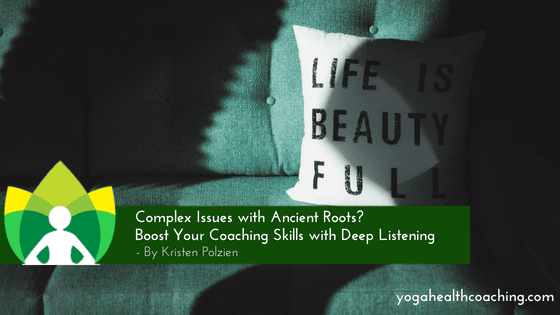
Complex Issues with Ancient Roots? Boost Your Coaching Skills with Deep Listening
Imagine, it’s laser coaching time.
You ask for a volunteer:
“Last week, we covered Healthy Eating Guidelines. We agreed to focus on avoiding snacking between meals. Who’s hit a problem with this habit?”
Susan speaks up,
“How can I possibly stop snacking? I just can’t do it. My hunger is like a raging fire. If I don’t eat every 2-3 hours, I’ll lose focus and bite someone’s head off!”.
Yikes!
Susan’s problem has roots spreading in all directions.
Where do you start digging for a solution? Do you automatically shift to problem solving mode and try to incinerate the problem?
You feel the tension rising from your heart to your head.
Easy, firewoman! Back away from the heat.
You’re about to discover the X factor of problem solving and boost your coaching skills.
Shhh…Are you listening?
Habits (Good and Bad) Have Ancient Roots
Do you get fired up every time your boss or colleague points out a mistake you made? Your chest burns, heart races, fists clench. Your fiery tendency is not something you picked up last week. Your habitual response has a history that may be rooted in how you were scolded as a kid.
Now, when you feel those flaming sensations rise up, you dive into a pint of Chunky Monkey. Cool and sweet to the rescue!
You see what I mean? Deep Roots!
As you guide members through the 10 habit changes, you expose gnarly patterns.
Back to Susan… So what do you do?
Do you stay on the surface? Insist that Susan sticks to the “no snacking rule” or do you dare to dig deeper? Maybe you don’t do either.
The Unspoken Phase of Problem Solving
When you’re laser coaching in a group or one-on-one setting, you’ve got 15 minutes (max) for problem solving. No time to waste, that’s why it’s called laser coaching!
You can S.O.L.V.E. any problem with the right formula:
- S.tate the problem
- O.utline the problem
- L.ist possible solutions
- V.iew the pros and cons of each solution
- E.xecute and evaluate your solution
But sometimes we need to back off the heat and allow more space for transformation. Like a plant that needs air and space to breathe and expand, deeply rooted problems need the same care.
How can you offer air and space to your members’ problems?
Deep Listening…
“Deep Listening is a way of being in the world that is sensitive to all facets of our experience—external, internal, and contextual (body, mind, and speech). It involves listening to parts we frequently are deaf to.”
David Romek, Deep Listening.
Our tribe knows the value of Deep Listening, it’s one of our Ground Rules for Dynamic Groups.
Listen Deeply:
When your group meets, practice and receive deep listening. Listening deeply means you participate in 100% receptivity mode. When a member speaks, you connect with the essence beneath their words. You turn up your care and allow yourself to be impacted by their learning. Deep listening is the glue that holds an evolutionary conservation together. Your listening has depth that you should actively dive into when you’re with your group. If you do, an evolutionary tension arises that propels your group into dynamic growth.
Amen.
David Rome shares that the quality of deep listening is “generous, empathic, supportive, accurate, and trusting”, David Rome, Deep Listening.
Sounds great, eh? But how do we actually practice Deep Listening?
The Deep Listening Experiment
David Rome offers a multi-layered model for deep listening, called “Embodied Listening”. While I have not completed his training, I was intrigued.
So, I developed my own experiment and tested it with my accountability partner. I linked my expertise (movement science and behavior change) with Embodied Listening techniques.
The essence is to create a safe space for deep listening and connection to felt senses. Energetically, this approach gives a problem air and space to breathe and be expressed before adding the fire of transformation.
During the process your role is to be a listener. It’s not your job to “be helpful,” to problem-solve or commiserate or evaluate, but simply to be mindfully present.
Tough, right? I know!
You may not arrive at an answer or a specific action plan, rather the goal is to focus and listen to the problem.
Trust. In time, you will ease your member to a solution.
Listen to our experiment here. (Heads and hearts open, it’s a 40 minute exchange.)
The 6 basic steps of the Deep Listening Experiment are:
- Express the Problem: Ask your member to present a problem.
- Move with the Problem: Guide your member through a few minutes of gentle movement. I chose qigong-based movements. Choose your own preferred movement form. Deep listening is subtle. Flowing, spacious, expansive movements facilite a softer energetic quality. Less heat, more space.
- Connect with the Felt Sense: Ask your member to sense the energetic quality of the problem.
- Name the Problem: Ask your member to allow a phrase or an image come up from the felt sense.
- (Encourage silence during the sensing and naming steps 3 & 4)
- Express the Experience: Allow the member to share the quality and phrase they connected to the problem.
- Cleanse the Space– Guide your member through gentle movement to ease the tension that may surface with the problem. Given its roots, gentle movement through space can lighten the energy before you transition.
Optional Step 7: If time permits, offer space for an action plan. Ask your member if they are ready, willing and able, to share a next step for transforming the problem. As you’ll hear in our experiment, your members (or partner) may come up with a next step on their own. We often find our own solution when offered the space to be heard.
When to Use Deep Listening
A deeply rooted problem likely extends beyond one specific habit. The types of problems that benefit from deep listening have old roots. When you stumble upon these problems, you may lose your breath.
Gasp!
Let your reaction cue you to open up space for deep listening.
Deep listening is a comforting fit for habit challenges that have received little attention. Those problems rotting like old cheese in the back of the refrigerator. Damn that rotten resistance.
Or try deep listening with challenges that are fresh, yet feel foreign or difficult, like the green coconut your neighbor gifted you. You’ll often find these early on in the habit changing journey. So, when you scratch your head, thinking ”How the hell do I cut into this?”, this is the time for deep listening.
Be creative, flexible and receptive.
Practice and Receive
Deep listening is a skill we all need to practice.
Design your own experiment with subtle elements of air and space. Give the problem gentle movement and space to be sensed and held, without feeling like you’ve got to scorch it with a blowtorch.
Use our Deep Listening Experiment as a loose guide to create your own experiment with friends, family and members.
Deep listening takes your coaching to a more spacious, higher vibration.
You’ll feel it and your members will too. Everyone loves to be heard.
Enjoy and share your experiments with our tribe.
We are here for you.



